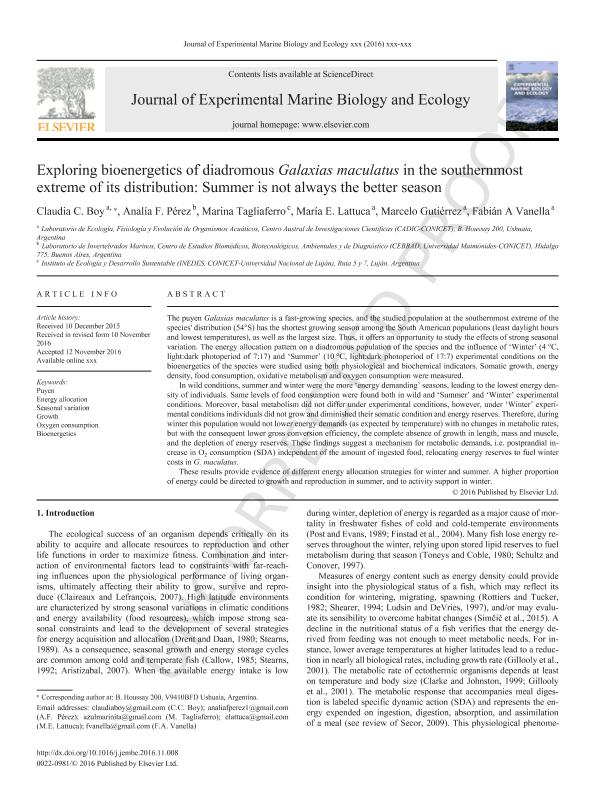Artículo
Exploring bioenergetics of diadromous Galaxias maculatus in the southernmost extreme of its distribution: Summer is not always the better season
Boy, Claudia Clementina ; Pérez, Analía Fernanda
; Pérez, Analía Fernanda ; Tagliaferro, Marina Beatriz
; Tagliaferro, Marina Beatriz ; Lattuca, María Eugenia
; Lattuca, María Eugenia ; Gutierrez, Marcelo Eduardo
; Gutierrez, Marcelo Eduardo ; Vanella, Fabián Alberto
; Vanella, Fabián Alberto
 ; Pérez, Analía Fernanda
; Pérez, Analía Fernanda ; Tagliaferro, Marina Beatriz
; Tagliaferro, Marina Beatriz ; Lattuca, María Eugenia
; Lattuca, María Eugenia ; Gutierrez, Marcelo Eduardo
; Gutierrez, Marcelo Eduardo ; Vanella, Fabián Alberto
; Vanella, Fabián Alberto
Fecha de publicación:
03/2017
Editorial:
Elsevier Science
Revista:
Journal of Experimental Marine Biology and Ecology
ISSN:
0022-0981
Idioma:
Inglés
Tipo de recurso:
Artículo publicado
Clasificación temática:
Resumen
The puyen Galaxias maculatus is a fast-growing species, and the studied population at the southernmost extreme of the species’ distribution (54°S) has the shortest growing season among the South American populations (least daylight hours and lowest temperatures), as well as the largest size. Thus, it offers an opportunity to study the effects of strong seasonal variation. The energy allocation pattern on a diadromous population of the species and the influence of ‘Winter’ (4 °C, light:dark photoperiod of 7:17) and ‘Summer’ (10 °C, light:dark photoperiod of 17:7) experimental conditions on the bioenergetics of the species were studied using both physiological and biochemical indicators. Somatic growth, energy density, food consumption, oxidative metabolism and oxygen consumption were measured. In wild conditions, summer and winter were the more ‘energy demanding’ seasons, leading to the lowest energy density of individuals. Same levels of food consumption were found both in wild and ‘Summer’ and ‘Winter’ experimental conditions. Moreover, basal metabolism did not differ under experimental conditions, however, under ‘Winter’ experimental conditions individuals did not grow and diminished their somatic condition and energy reserves. Therefore, during winter this population would not lower energy demands (as expected by temperature) with no changes in metabolic rates, but with the consequent lower gross conversion efficiency, the complete absence of growth in length, mass and muscle, and the depletion of energy reserves. These findings suggest a mechanism for metabolic demands, i.e. postprandial increase in O2 consumption (SDA) independent of the amount of ingested food, relocating energy reserves to fuel winter costs in G. maculatus. These results provide evidence of different energy allocation strategies for winter and summer. A higher proportion of energy could be directed to growth and reproduction in summer, and to activity support in winter.
Archivos asociados
Licencia
Identificadores
Colecciones
Articulos(SEDE CENTRAL)
Articulos de SEDE CENTRAL
Articulos de SEDE CENTRAL
Citación
Boy, Claudia Clementina; Pérez, Analía Fernanda; Tagliaferro, Marina Beatriz; Lattuca, María Eugenia; Gutierrez, Marcelo Eduardo; et al.; Exploring bioenergetics of diadromous Galaxias maculatus in the southernmost extreme of its distribution: Summer is not always the better season; Elsevier Science; Journal of Experimental Marine Biology and Ecology; 488; 3-2017; 102-110
Compartir
Altmétricas



